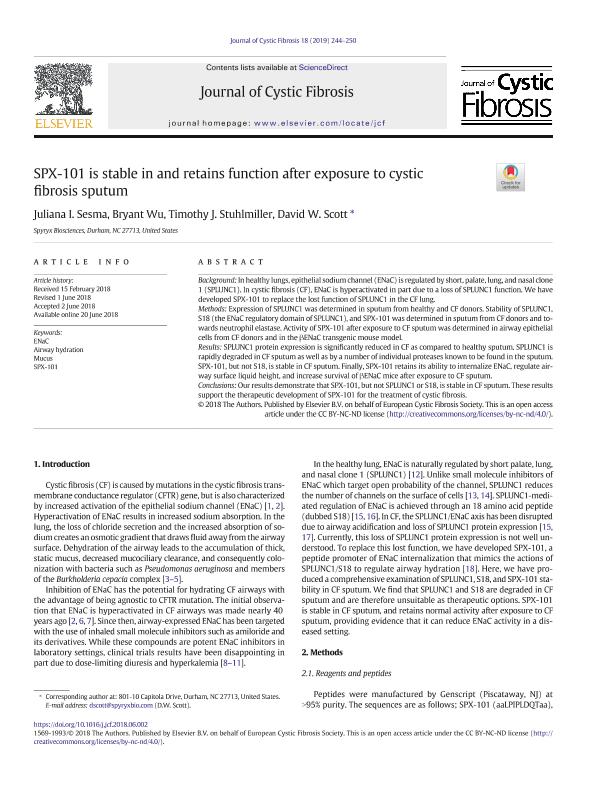Mostrar el registro sencillo del ítem
dc.contributor.author
Sesma, Juliana

dc.contributor.author
Wu, Bryant
dc.contributor.author
Stuhlmiller, Timothy J.
dc.contributor.author
Scott, David W.
dc.date.available
2020-01-30T19:31:01Z
dc.date.issued
2019-03
dc.identifier.citation
Sesma, Juliana; Wu, Bryant; Stuhlmiller, Timothy J.; Scott, David W.; SPX-101 is stable in and retains function after exposure to cystic fibrosis sputum; Elsevier Science; Journal Of Cystic Fibrosis; 18; 2; 3-2019; 244-250
dc.identifier.issn
1569-1993
dc.identifier.uri
http://hdl.handle.net/11336/96267
dc.description.abstract
Background: In healthy lungs, epithelial sodium channel (ENaC) is regulated by short, palate, lung, and nasal clone 1 (SPLUNC1). In cystic fibrosis (CF), ENaC is hyperactivated in part due to a loss of SPLUNC1 function. We have developed SPX-101 to replace the lost function of SPLUNC1 in the CF lung. Methods: Expression of SPLUNC1 was determined in sputum from healthy and CF donors. Stability of SPLUNC1, S18 (the ENaC regulatory domain of SPLUNC1), and SPX-101 was determined in sputum from CF donors and towards neutrophil elastase. Activity of SPX-101 after exposure to CF sputum was determined in airway epithelial cells from CF donors and in the βENaC transgenic mouse model. Results: SPLUNC1 protein expression is significantly reduced in CF as compared to healthy sputum. SPLUNC1 is rapidly degraded in CF sputum as well as by a number of individual proteases known to be found in the sputum. SPX-101, but not S18, is stable in CF sputum. Finally, SPX-101 retains its ability to internalize ENaC, regulate airway surface liquid height, and increase survival of βENaC mice after exposure to CF sputum. Conclusions: Our results demonstrate that SPX-101, but not SPLUNC1 or S18, is stable in CF sputum. These results support the therapeutic development of SPX-101 for the treatment of cystic fibrosis.
dc.format
application/pdf
dc.language.iso
eng
dc.publisher
Elsevier Science

dc.rights
info:eu-repo/semantics/openAccess
dc.rights.uri
https://creativecommons.org/licenses/by-nc-nd/2.5/ar/
dc.subject
AIRWAY HYDRATION
dc.subject
ENAC
dc.subject
MUCUS
dc.subject
SPX-101
dc.subject.classification
Bioquímica y Biología Molecular

dc.subject.classification
Medicina Básica

dc.subject.classification
CIENCIAS MÉDICAS Y DE LA SALUD

dc.title
SPX-101 is stable in and retains function after exposure to cystic fibrosis sputum
dc.type
info:eu-repo/semantics/article
dc.type
info:ar-repo/semantics/artículo
dc.type
info:eu-repo/semantics/publishedVersion
dc.date.updated
2020-01-29T22:35:50Z
dc.journal.volume
18
dc.journal.number
2
dc.journal.pagination
244-250
dc.journal.pais
Países Bajos

dc.journal.ciudad
Amsterdam
dc.description.fil
Fil: Sesma, Juliana. Spyryx Biosciences; Estados Unidos. Consejo Nacional de Investigaciones Científicas y Técnicas; Argentina
dc.description.fil
Fil: Wu, Bryant. Spyryx Biosciences; Estados Unidos
dc.description.fil
Fil: Stuhlmiller, Timothy J.. Spyryx Biosciences; Estados Unidos
dc.description.fil
Fil: Scott, David W.. Spyryx Biosciences; Estados Unidos
dc.journal.title
Journal Of Cystic Fibrosis

dc.relation.alternativeid
info:eu-repo/semantics/altIdentifier/doi/http://dx.doi.org/10.1016/j.jcf.2018.06.002
dc.relation.alternativeid
info:eu-repo/semantics/altIdentifier/url/https://www.sciencedirect.com/science/article/pii/S1569199318306271
Archivos asociados
